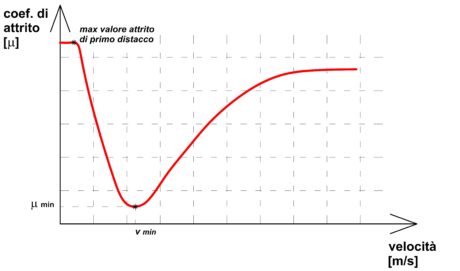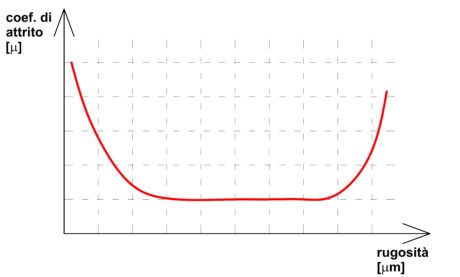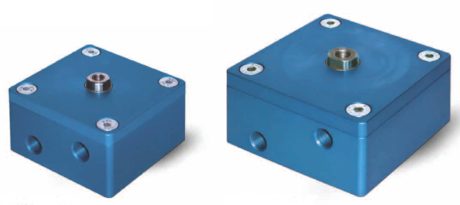Some of the main themes connected with friction in pneumatic components: state of the art and researches aimed at higher efficiency of components themselves.

The interaction of two generic bodies can happen in different ways, for instance through mutual exchange of stresses due to different physical quantities, like magnetic, electrostatic and gravitational fields. If we focus our study on the devices used in engineering ambit, and especially in the hydraulic and pneumatic ones, the mutual interactions springing from field forces are generally negligible with regard to the forces caused by the direct contact among bodies themselves. The concept of “contact force”, which is studied in detail by particular disciplines such as tribology and the mechanics of contact with friction, implies important engineering aspects and issues that are still the subject of theoretical and applied research.
Friction in pneumatic cylinders
The study of friction in pneumatics arouses lively interest for the implications connected with the environment, the efficiency of plants and management costs. State-of-the-art pneumatic components are designed according to criteria of low cost, high performance/weight ratio, lightness, reliability and duration. Friction is in fact of fundamental importance for performances in pneumatics since, in statics and dynamics, cylinders and valves are seats of friction: they have estimated that in cylinders about 20% of the force generated by the pressure on the piston is lost in friction.
Friction in pneumatic cylinders (opening fig., 1 and 4) depends on both contact forces among seals, centering ring and barrel, and on the contact among seals, bushes and rod. Fundamental are the extension and the surface finish of the contact zones where seals slide, also in presence of lubricants like greases and oils. In general, the friction coefficient µ defined as ratio between tangential and normal actions, depends on speed, generating three behaviours, as schematized in the graph of fig.2 where we have three zones: starting or static friction, which corresponds to the highest value of the friction coefficient (direct contact between seal and dynamic surface); mixed friction, which corresponds to the lowest value of the friction coefficient (a mixed behaviour between dry and lubricated); lubricated friction, which corresponds to the steady-state value (a layer of lubricating liquid is interposed between seal and dynamic surface).

If we analyse the diagram in fig.2, we can notice that, at the beginning of the motion, friction is high because the static friction coefficient is higher than in other motion conditions; then, with the speed rise, a fluid film interposes between the seal and the surface in motion, reducing the contact area and, consequently, friction. In steady condition, to which a speed rise corresponds, the contact between surfaces misses completely and friction starts increasing progressively owing to the shear stresses of the fluid itself.
Friction, between a dynamic seal and the tightening surface, depends on the following factors: the design, or profile, and the material of the seal, the fluid, the pressure, the temperature, the speed and the surface finish. Concerning this, the seal performances are hardly analysed because a certain number of empiric factors, specific in the design of the seal itself, is implied. However, basically, friction is obviously proportional to pressure, even if the friction coefficient at stake can change due to speed, temperature, material and surface finish.

There are, in fact, some cases (fig.3) where some “cold” micro-welds of materials in contact are determined; this demonstrates that in cases of fine finish, the friction coefficient is higher than in case of mean finish. Owing to the above-mentioned factors, in pneumatic components are used several types of seals, protagonist of components’ friction behaviour.
Choice of the seal typology
The choice of a seal typology instead of another in general depends on roughness, too, meant as the whole of differences of the real surface degree compared to the theoretical one. Any surface, even if machined with great accuracy, reveals unevenness consisting of grooves and peaks that determine local deviations, more or less extended, of the real surface from the nominal one. It is known that surfaces with high surface finishing degree feature better resistance to corrosion than the surfaces with high roughness; however, it is not certain that reaching the lowest possible roughness level is always the best solution because it generally implies high machining costs. Moreover, it is worth pointing out that a minimal roughness is indispensable to allow the lubricant to adhere to the surface itself and, consequently, to perform its task suitably. The choice of a seal type rather than another, then, depends on the roughness degree of the sliding surface; in general, for lubricated sliding surfaces, the most suitable roughness values are equal to 0.5 ÷ 1 µm. For not lubricated seals, a lower roughness is advisable, to 0.2 µm, whereas a rough surface, with roughness exceeding 1.5 µm, quickly wears out seals.


We can state the best condition of a counterpart surface of a seal is represented by a surface without surface ruggedness but provided with slightly deep grooves acting as pockets for the lubricant accumulation. The seal shape is important to the ends of its service life, too; a layer of lubricant with minimum thickness on the walls of the sliding surface grants the onset of lift effects that tend to detach the seal itself, and a lip-shaped section with sharp edges allows limiting the thickness of the lubricant layer whereas a lip-shaped section with rounded edges allows conserving the lubricant film longer. Among the various seal typologies the market can offer, O-rings (fig. 5) represent one of the most common: user-friendliness and low cost of O-rings have made them one of the most common and used seal typologies.
Many elastomeric compounds have been developed and they can suit the most different use conditions. To assess the good behavior of a particular compound, once assigned use stresses, some parameters must be fixed. The sealing efficiency of an O-ring is linked with the mechanical features of the material and factors that modify its characteristics. Among such specifications, the coefficient of thermal expansion and the permeability to gases play an important role for the sealing efficacy.
Conclusions
The study of friction of pneumatic components is of fundamental importance for pneumatics, also in view of the development of new systems and components. Leader sector companies try to grant customers pneumatic components that dissipate the minor mechanical energy under form of friction, in a market prospect that provides for low cost, high performance/weight ratio, lightness, reliability and duration.
The author thanks the company Omas srl, headquartered in Alpignano, Turin (Italy), which has kindly provided technical information and photographic material. SEE ALSO THE VIDEO
[su_box title=”Still on the origin of friction”]The origin of friction derives from adhesion or cohesion forces that emerge in materials in relative motion and its study has been analysed since antiquity as important factor that concerned the motion of bodies, until the first studies by Leonardo da Vinci and Galileo Galilei, where friction is classified as physical phenomenon of bodies’ interaction (see also box in the previous article). In particular, Leonardo da Vinci, through experiments resembling traditional ones still used in the laboratories of schools such as “ Liceos”, (i.e. Italian secondary schools), or technical Institutes (inclined plane, block pulled by weights through ropes and transmissions), stated the friction force is independent from the contact area but proportional to the load, with a friction coefficient equal to ¼ for all bodies he studied, in case of clean and smooth surfaces. For the friction definition, from an engineering point of view, fundamental were the studies by the French scientists G. Amontons (1663-1705) and C.A. Coulomb (1736-1806). Amontons, studying the friction cause in surface unevenness, considered as stiff obstacles or elastic protuberances deformed by the body in motion, defines friction as due to the necessary force to surmount ruggedness and he concludes the force is proportional to the load and does not depend on the contact area, properties known as Amontons laws. Coulomb thinks the sliding friction, generated by the sliding of a body on another, is produced by the degree of surface harshness; such harshnesses fit more or less depending on the load and are deformed laterally under a tangential stress. This hypothesis gives birth to the following laws: friction depends on the nature of the bodies in contact and on the machining degree of their surfaces; friction is directly proportional to the normal pressure the body in motion exerts on the plane; static friction is about 1.5÷3 time higher than the one during the motion; friction does not depend on speed during motion, provided that the value of 20 m/s is not exceeded, otherwise, above it, friction decreases; friction does not depend on the extension of the contact surface.



